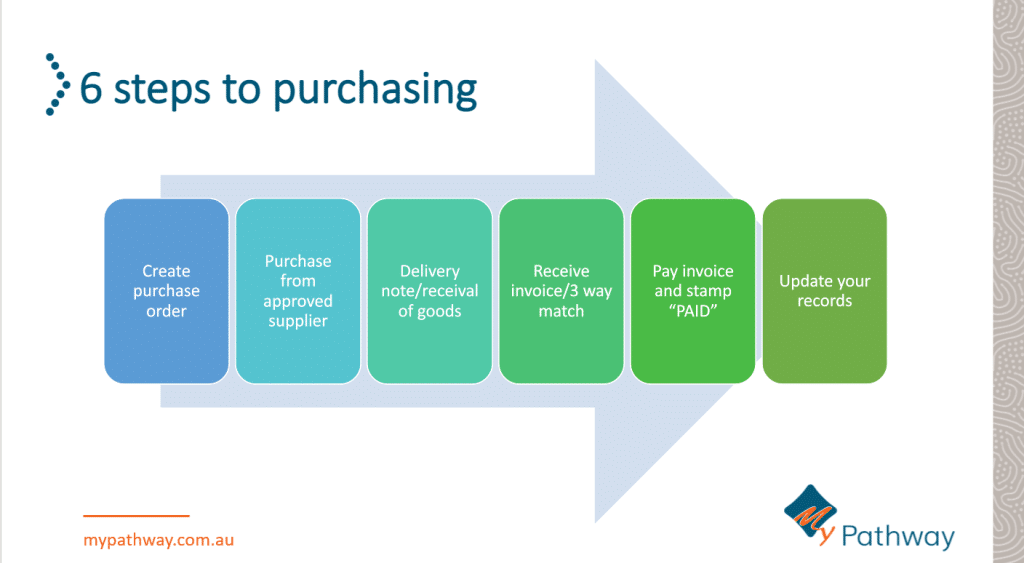Coordinate business resources
About the Unit
This unit identifies the importance of managing your resources. It covers the methods for acquiring and allocating them effectively and how to monitor and maintain them to ensure your costs are controlled and outputs maximised.
Start with the Study guide BSBOPS401.
How to calculate the start up costs for my business?
Learning Outcomes
BSBOPS401-Co-ordinate Business Resources
- Establish required resources
- Acquire and allocate resources
- Evaluate resource allocation and usage
- Improve resource allocation and usage

Click on Tabs for Learning Content
What is a Business Resource?
Any physical or virtual entity of limited availability required to run your business.
Examples include: Electricity, internet, office equipment, delivery van, raw ingredients, consumables.
Even your intellectual property and time are resources!
There are 4 Steps to Resource Management:
- Establish Resource requirements
- Acquire the resources
- Manage the Resources
- Control Resource Usage
Resources can be financial, physical, human and intellectual. Considering your budget, what assets you physically need to run your business, staffing and business support requirements will help you identify your needs. You may not need everything now, but a clear process will allow you to prioritise and plan for the future.
How to Plan your Resources
Step 1- Identify what resources you need now and also list ones you may need in the future.
Step 2- Put an estimate on the time each resource needs and what you need it for.
Step 3- Double check you haven’t missed anything.
Step 4- What is the quantity and quality you require?
Step 5- Determine your budget.
Step 6- Prioritise your list, starting with what you NEED now.
Step 7- Gain advice from a specialist (accountant) about tax advantages and acquisition options.
Step 8- Put an action plan in place aligned with your budget to acquire resources. (refer to Financial reports Assets, Establishment Costs and Profit & Loss)
➡Refer to Knowledge Question 2- Assessment 1.
Step 1- Identify your Resources
How you establish which resources you need may come from a number of sources. It could come from:
- your previous experience.
- others in the industry you have researched.
- a competitor analysis.
- a business mentor or specialist.
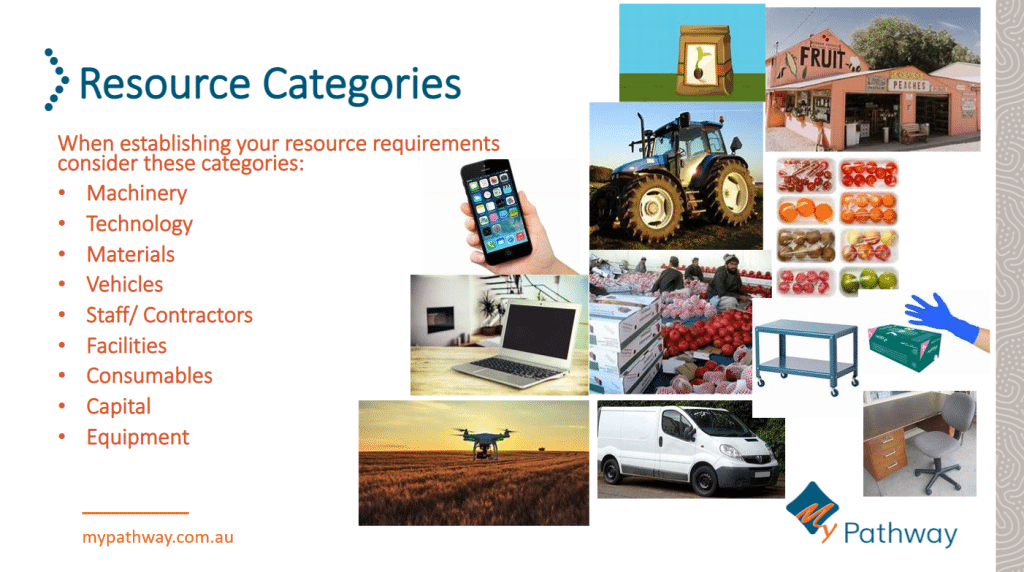
Assets
Assets are resources that can be current, non-current , and can also be known as Property Plant & Equipment (PPE). The link below explains the importance of these resources in business.
When you consider resource requirements, it is important to understand their function and how they contribute to the business. How important are they? How much money will they bring back into the business? Will they increase customer satisfaction?
Can you list the functions of the resources listed below?
Resource: Technology- Mobile phone
What's the Function?
Communication, sending emails, taking photos, recording videos.
Resource: Vehicle
What is its function for the business?
transport to customers, delivering goods
Resource: Consumables- Take away cups
Function:
serve coffee and take away drinks in.
Resource: Machinery- Tractor
Function
Used to produce the crops and products the business sells.
➡Refer to Knowledge Question 1- Assessment 1.
Step 4- Quantities
Establishing the correct quantities will ensure your business runs efficiently. Not enough stock, cash or resources can cause your production to slow, which will cause your sales to slow. Having too much stock can mean dead money sitting on the shop floor, depreciating in value every day.
Determining the correct quantities will come with experience. Forecasting sales and scheduling tasks and time will give you a calculated estimate for you to start on, until you build a history.
The schedule below is a great example of a tool you could use to help you plan your resources.
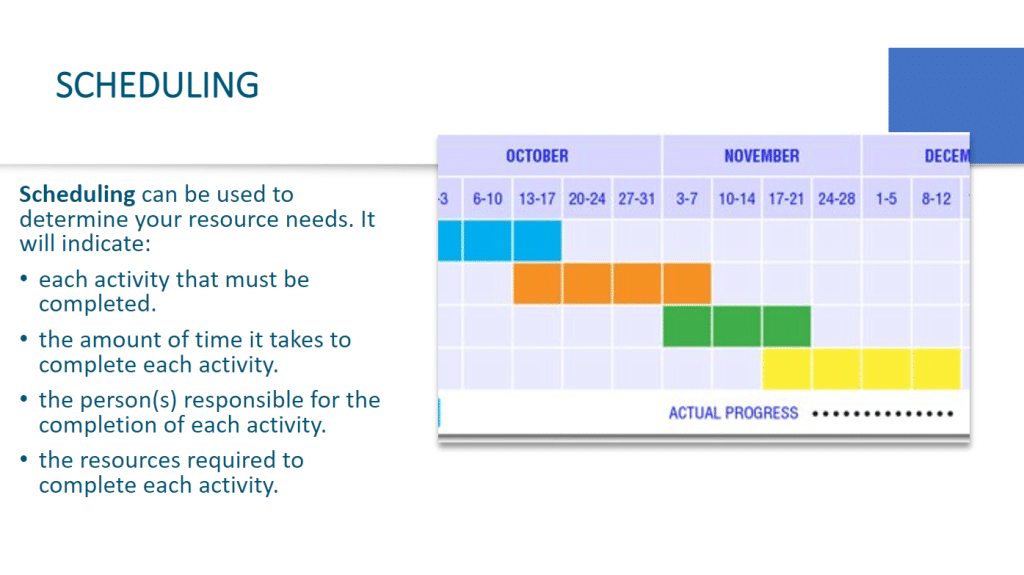
Step 5- Determine your budget
- Create a budget with the prices of everything you need. Compare bulk versus on demand.
- Refer to your financial sales projections.
- Refer to your cashflow forecast.
- Determine the quantities you need based on these figures.
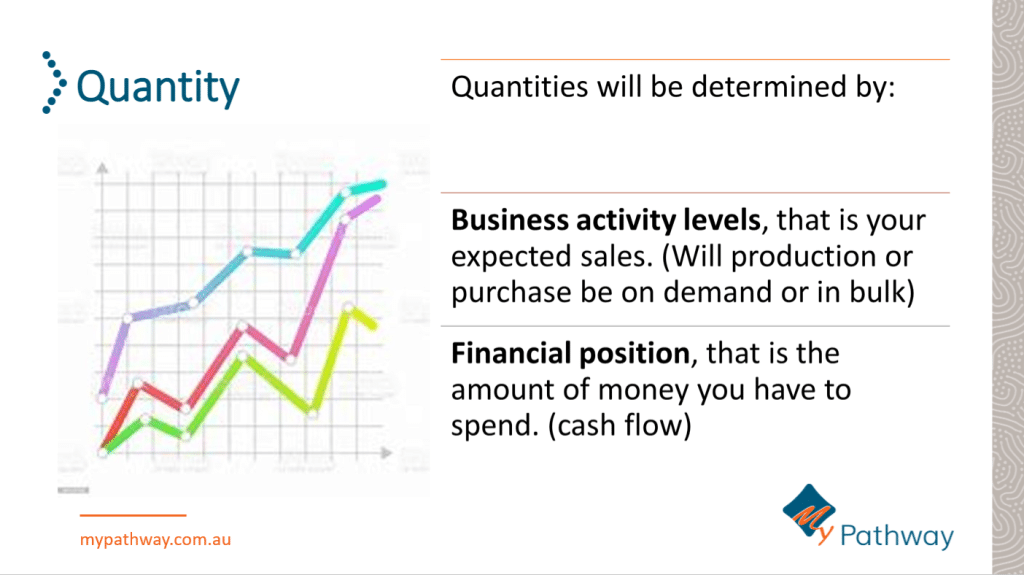
➡Refer to Activity 3- Assessment 2
Policies and Procedures for acquiring and monitoring resources.
Acquiring resources will affect your costs and your cashflow. Whether you decide to purchase, hire or lease will depend on your budget.
Monitoring the use of resources, ensuring they are productive and are not wasted or stolen will help you control your costs and be more profitable.
Developing policies and procedures will:
- Ensure all laws and regulations are followed for example, record keeping rules for taxation.
- Control your cash flow and costs by providing clear guidelines on how and when to order, receive and pay for stock throughout the procurement process.
- Ensure all stock is accounted for. Effective inventory procedures will reduce the risk of losing money through theft or mishandling of goods.
- Provide useful training material for new team members, ensuring clear communication and processes on how to control resources through effective management techniques.
Acquiring Resources
Acquisition is not just purchasing. In business, there are several options available when acquiring resources. This will depend on your budget, cashflow, how often you will use the resources or even how quickly technology changes. Hiring or outsourcing may be a better option for your business. Make sure you investigate the best option to suit your business goals.
Acquisition is not just purchasing
You can also:
Rent, Hire purchase, Outsource, Contract staff
Procurement
Is the process of sourcing, assessing and costing goods and services to ensure you get the best quality at the best price. The links below explain the process of procurement in more detail.
The 7 R’s of Procurement
It is imperative that you control your costs by shopping around and finding the best deal for your business. It is not just about price. Consider the 7 R’s to Procurement:
- Right Quantity- can the supplier meet your demand?
- Right Quality – can the supplier consistently offer you the quality you expect for your customer?
- Right Time- can they deliver on time every time?
- Right Source- are they sourcing their products responsibly to suit your business ethics?
- Right Place- will they deliver to where you want them to deliver to?
- Right Terms – Does the supplier offer you the right terms and conditions or payment terms that suit your business?
- Right Price- Is the price fair and reasonable, allowing you to make enough profit?
Key Takeaways
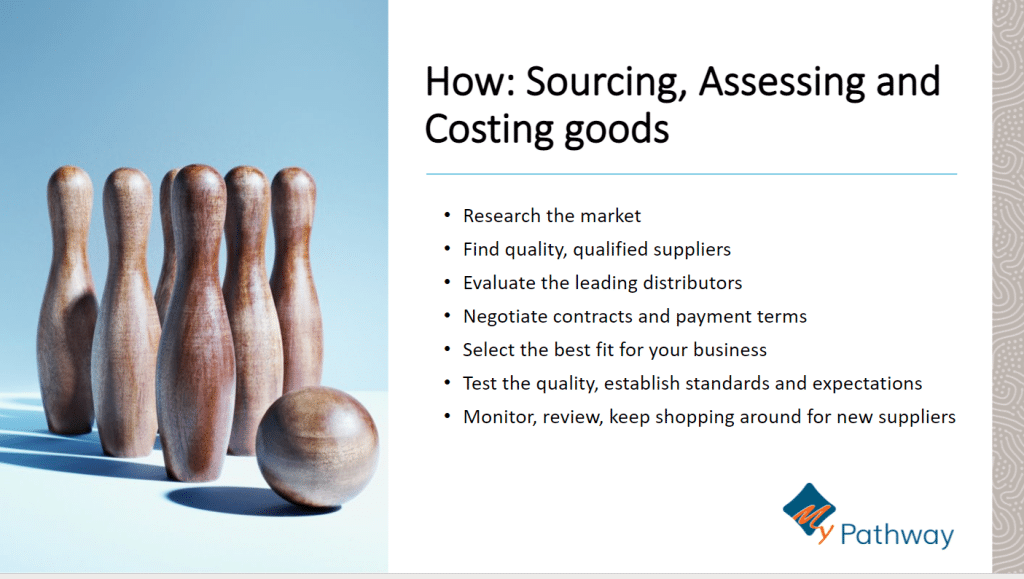
➡Refer to Knowledge Question 4- Assessment 1.
Laws and Regulations to consider when sourcing your product.
Ask yourself: is the product Safe, Ethical, Legal?
The links below outline the laws and regulations you may need to consider when sourcing your resources.
Procedures
Procedures are the set of instructions or rules that a business implements to ensure compliance with government legislation and industry rules and regulations.
Procedures need to be in place for every step of the Resource Management process. These will control costs, improve efficiencies, reduce supply issues and maintain good cashflow management.
Why do we need procedures?
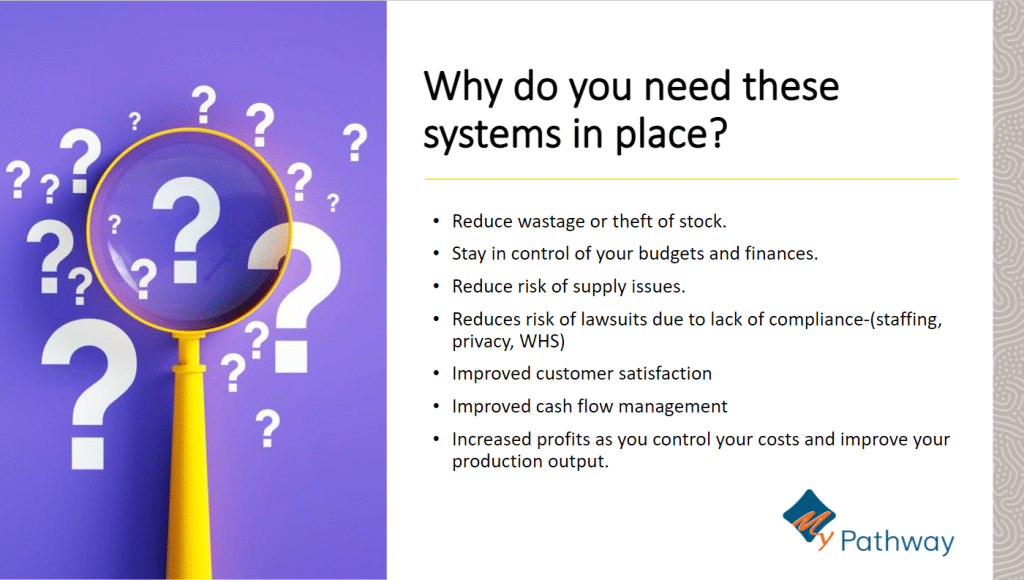
Procedures and Systems for Use of Resources
Systems need to be established in order to streamline the implementation of resources. You must consider:
- Your budget and approval process.
- Developing and monitoring resource contracts.
- the ordering process of stock and materials.
- the storage of stock and materials.
- the installation and IT support for communications equipment and software.
- the maintenance and repair of machinery and equipment.
- recruitment, induction and supervision of employees and contractors.
➡Refer to Question 3- Assessment 1
Being adaptable to changes in Business
Change is inevitable. Preparing your business to minimise risks and adapt quickly is essential. Having procedures in place to regularly review and monitor your resource usage and financials will allow you to identify changes quickly and adapt to any unforeseen circumstances that may occur.
Procedures could include:
- Set Key Performance Indicators (KPI’s), check them weekly.
- Monitor customer feedback every week.
- Measure actual sales against forecast performance every week.
- Check cashflow reports monthly.
- Have alternate suppliers set up in case of supply issues.
- Source financial options in case you need an emergency injection of funds.
- Audit financial records to ensure compliance with the ATO.
- Regularly check legislation updates via industry newsletters or networking sites.
- Design a strong contingency or Disaster plan, communicate and train it to others.
➡Complete Question 5- Assessment 1
Purchasing Procedures
Key Takeaways
Six steps of purchasing
Ordering Procedures
In order to control stock and costs, you need a process in place that controls who does the ordering and who receives the order. This will reduce the risk of you being overcharged for goods you did not receive or receiving goods of inferior quality. The videos below describe some processes you could implement.
A document trail and accountability ensures you control your costs from the start. Purchase orders control the stock coming into the business. They need to be traceable, signed off by a responsible person and have clear specifications of what you are ordering. This purchase order will be compared to your delivery note and finally your invoice. This 3 way check will ensure you are controlling the ins and outs of your stock and managing your costs and quality control.
Ordering the correct level of stock to ensure you don’t have dead money sitting on the production floor takes planning. One effective inventory management strategy is Just In Time ordering or JIT.
This video explains how JIT works.
Key Takeaways
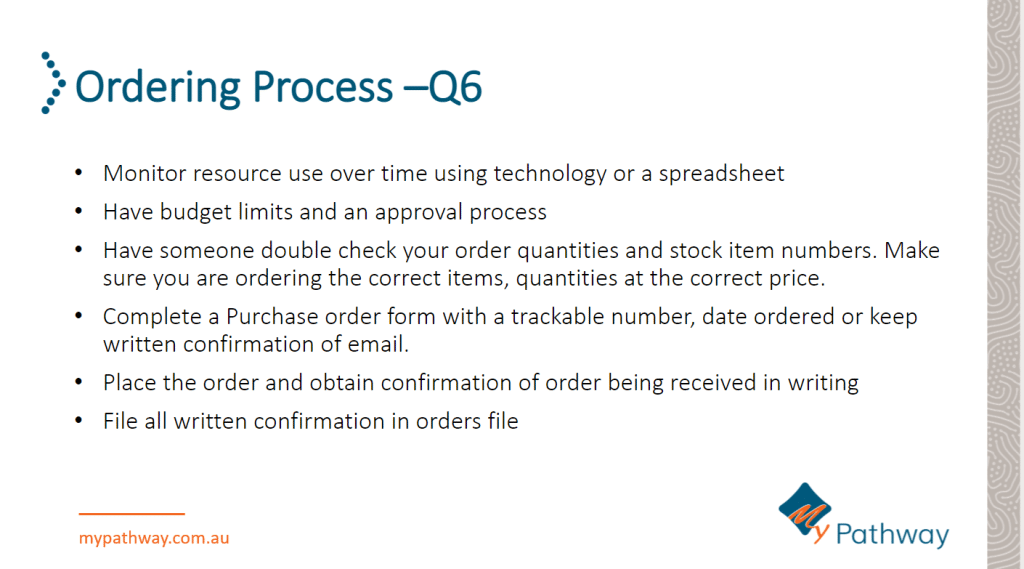
➡Complete Question 6-Assessment 1
Dispatch Procedures- Stock leaving your Business
Controlling stock that leaves the business also needs documentation. You need proof in case the customer claims they have not received the goods. You also need to be able to account for all stock ingoing and outgoing when counting inventory. Nothing is to leave the business without a receipt which you file accordingly.
Key Takeaways
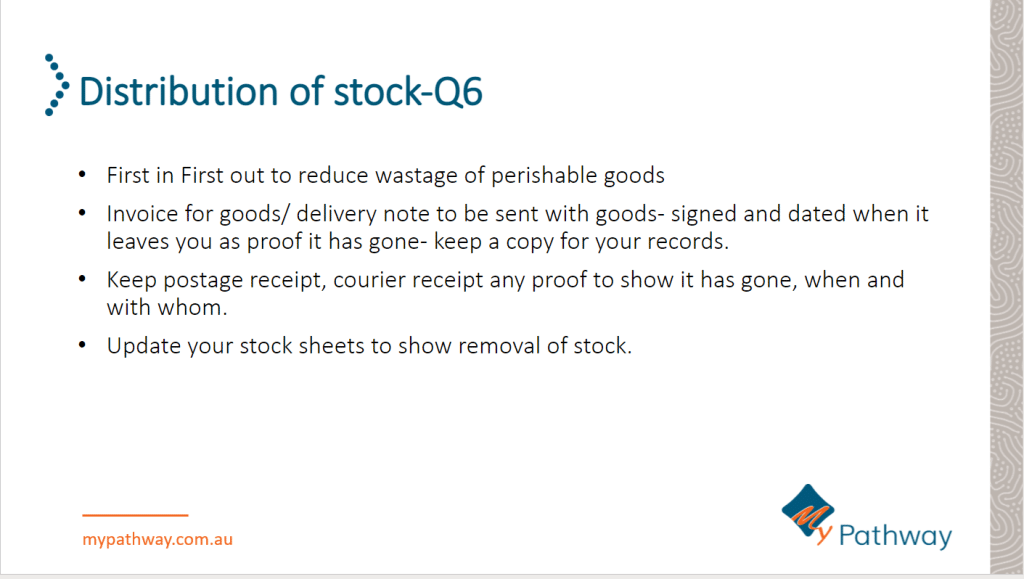
➡Complete Question 6-Assessment 1
Receivals Procedure- goods coming into the business
Below is an example of a receival process you may consider. The important points are that a responsible person double checks the quality and quantity of goods delivered BEFORE signing off.
Key Takeaways
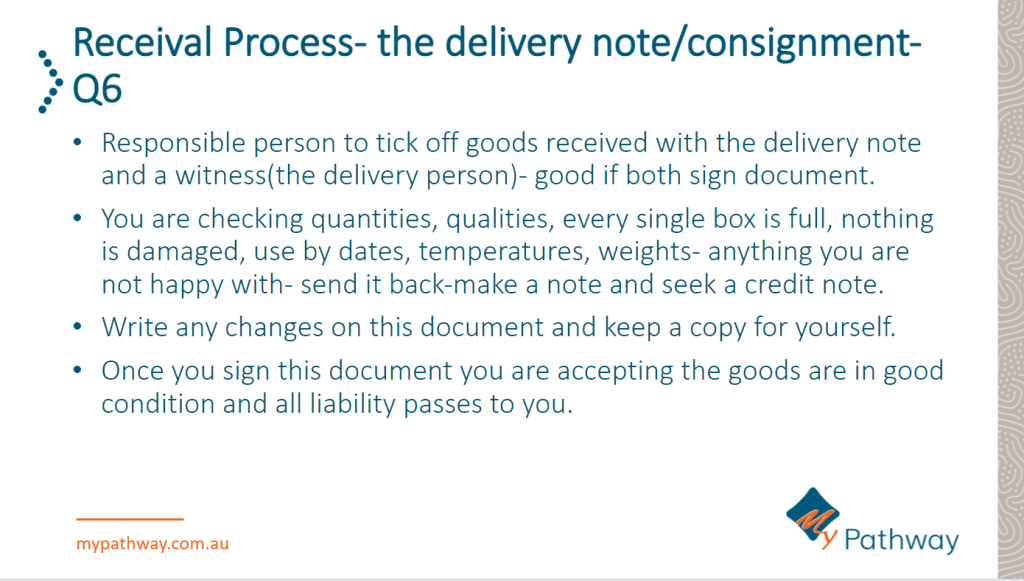
➡Complete Question 6-Assessment 1
Record keeping and Inventory procedures
Procedures are “HOW” you make it happen. Having a clear document trail or process, will allow you to control your costs effectively, in every step of the purchasing process.
Once you have received the goods, compare these three (3) documents:
- the purchase order will confirm what you ordered.
- the delivery note has been checked confirming what has been received.
- the invoice – what has been charged matches what you have received.
***If not- get onto the supplier and fix it.***
Which 3 Documents do you check for a 3 - way match?
Purchase order
Delivery or Consignment note
Invoice
Key Takeaways
You need a document trail for every step of the Resource Management Process.
- Check your actual sales results and compare to your forecast.
- Do a physical stock check and check how much money you have budgeted for.
- Create a purchase order with a trackable number.
- Receive and check all products with their dispatch/ delivery note.
- Receive and check invoice.
- Conduct the 3 Way Check.
- Pay invoice, date and file.
- Update stock records.
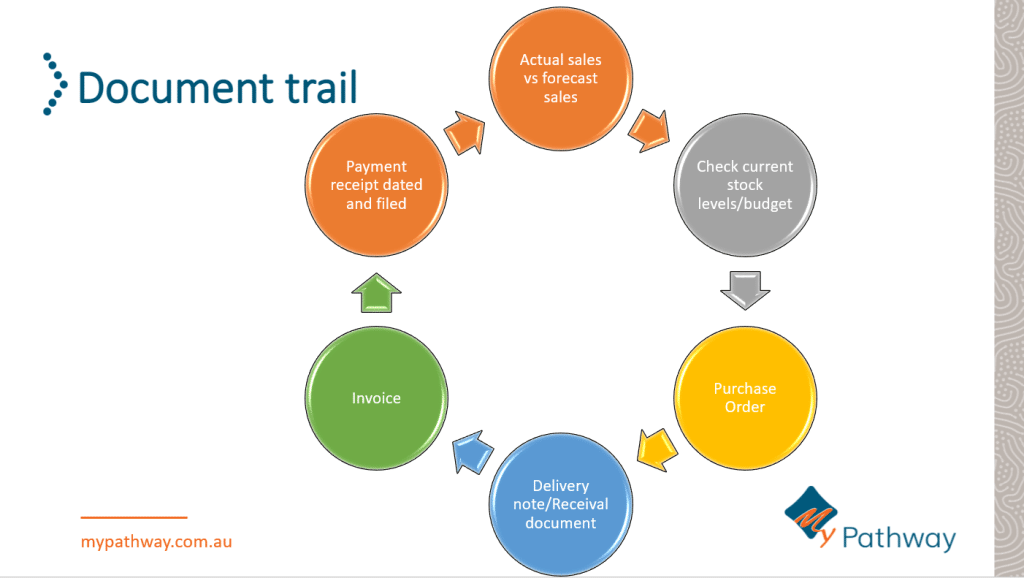
Monitoring & Maintaining Resources
Once you sign and accept the goods, they belong to you and are a cost to the business. Stock (inventory) is dead money until you sell it and convert it back into cash (WCC). In order to achieve suitable stock levels, you need to monitor it on a regular basis. Review past and current sales, compare them to your forecasts and adjust these forecasts if needed. Too much stock is a drain on your cashflow and not enough stock could mean you lose business and loyal customers.
It is also important to take care of the stock and store it safely and securely to avoid theft, damage or spoilage. The slides below offer suggestions on how you could do this.
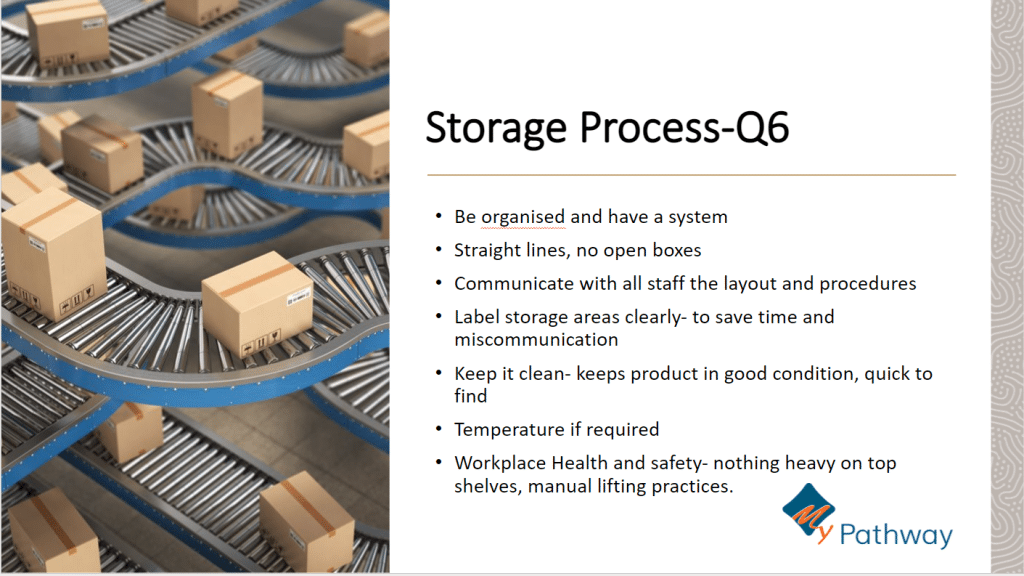
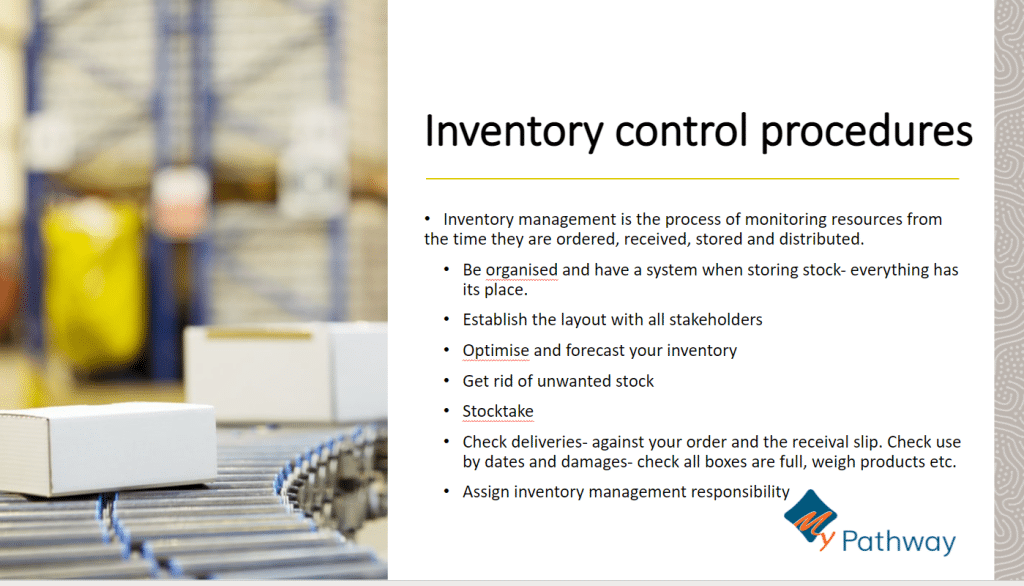
Maintaining your Resources
In order to obtain maximum output from minimum input, a business needs to maintain its resources.
Maintenance is a management process of repairing and maintaining buildings, plant, machinery and equipment in order to prevent breakdowns and disruptions to the provision of products and services.
A Preventative Maintenance plan can reduce the risk and severity of breakdowns and increase productivity.
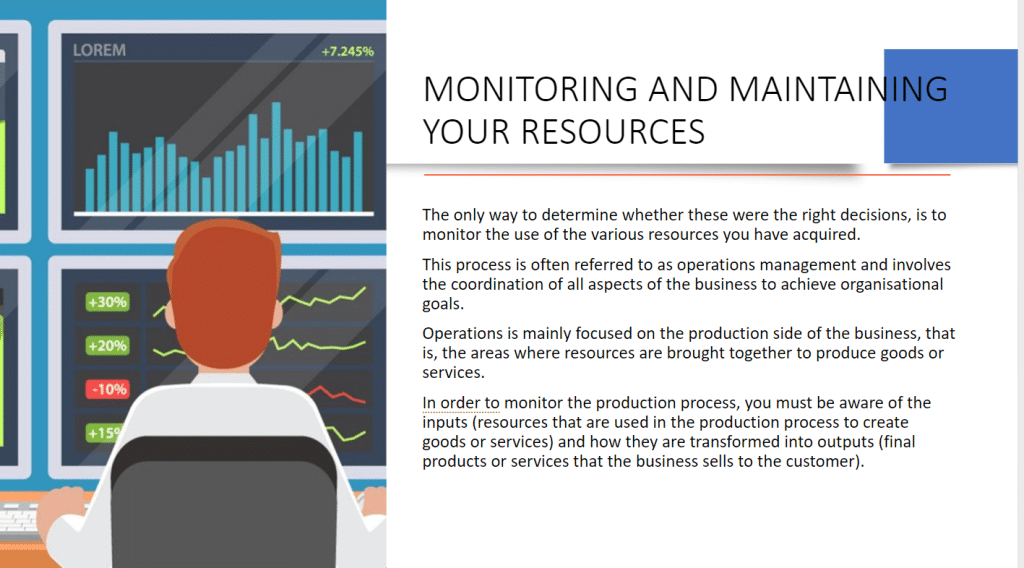
Evaluating the Effectiveness of your resource management processes.
Effective use of your resources is when you get maximum output for minimum cost. Procedures need to be in place to monitor stock levels, cashflow, understand future demand levels. If you have vehicles or equipment required to produce your goods or services, they need to be maintained so they don’t break down. There are several processes and formulas you can use to measure these outputs.
Some examples include:
- Stock Turnover rate- Regular stock takes of stock on hand will indicate your stock turnover rate. The higher the ratio the better.
- Staffing productivity – Staff wages / sales X 100% will give you a percentage. This percentage should be based on industry standards. If it is too low, it could mean you don’t have enough staff on to produce your goods and if it is too high, you have too many staff that are not being productive.
- Machinery productivity and if it is being utilised enough to give you your desired return on investment.
- Accounts payable versus accounts receivable – do you have sufficient cash resources for your future business forecasts?
Systematically reviewing these key performance areas will ensure you establish the correct levels of resources to maintain a sustainable business.
Below are two links that outline the formulas to use to calculate these:
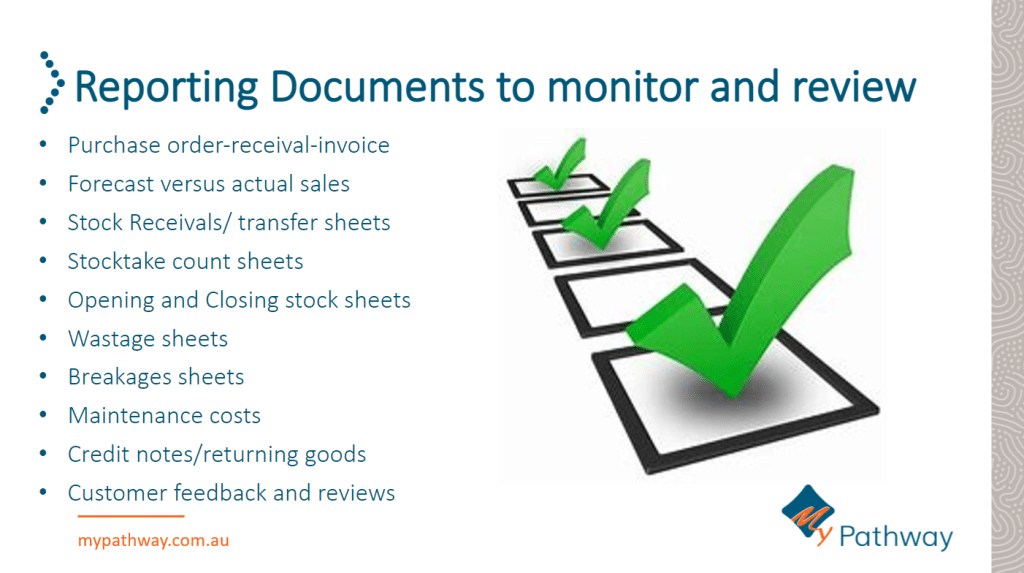
➡Complete Question 7-Assessment 1
Develop an Action Plan
Once you have identified any issues, you need to develop an Action Plan to fix these. An Action Plan or ARC (Action, Responsible, Completed) will allow you to identify the problem, list the actions required to fix the problem, list who is responsible for fixing these and by when. It is then everyone’s responsibility to meet regularly to discuss progress and outcomes as well as monitor the improvements.
As with Risk Management- we identify the risk, assess the risk, control or fix the risk and then monitor and review. It is continuous improvement that we follow with every aspect of our business.
In Conclusion:
- Always look for a way to streamline and reduce costs.
- Evaluate your usage and financial results often.
- Monitor external risks and competitors on a regular basis.
- Ask others for advice and support.
When co-ordinating, planning and purchasing resources, we often need to ask for advice from those more specialised or experienced than ourselves. Industry specialists, accountants, business advisers, customers, suppliers- they can all offer insight that can lead to improvements.
Remember- we can’t do it all on our own. Here are a few examples of who could support you.
Who could you consult about resources?
Accountant
Bookkeeper or tax agent could give you advice on reducing costs or better use of resources.
Who could you consult about resources?
Staff
They use the products daily, they speak to the customers, they can offer insights into demands
Who could you consult about resources?
Specialists
You could ask a computer technician about the best software to use, internet provider on the best internet coverage, bank manager about lending money, ATO about tax, Fairwork about hiring staff.
➡ Refer to Activity 1:
Name 3 Resources you plan to acquire- identify who you discussed your options with before making your decision and have you budgeted for this resource- how much is it?
Activity 2:
Open communication is vital in any organisation. Do you have any procedures in place that encourages staff to let you know when you are running low on stock? How do you identify resource needs from others recommendations?
Document 4- Assessment 3- Business Plan Instructions
- Write your full name on the top of the first page “Participant name:”
- Attach a completed copy of your Operational Plan to be marked.
- Attach the completed parts of your Financial Plan that are requested.
Check off the Assessment Submission Checklist
This will ensure you have completed all tasks and paperwork correctly and we won’t need to return anything before marking.
News feed

